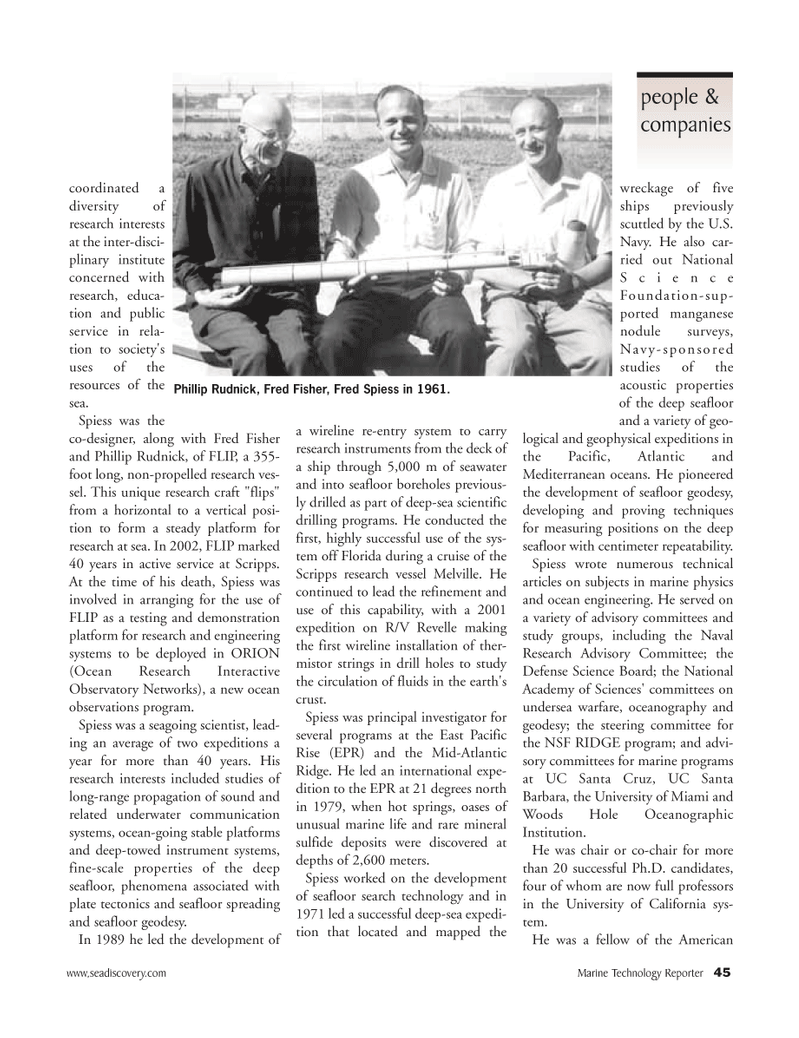
Page 45: of Marine Technology Magazine (November 2006)
Deep Ocean Exploration
Read this page in Pdf, Flash or Html5 edition of November 2006 Marine Technology Magazine
coordinated a diversity of research interests at the inter-disci- plinary institute concerned with research, educa- tion and public service in rela- tion to society's uses of the resources of the sea.
Spiess was the co-designer, along with Fred Fisher and Phillip Rudnick, of FLIP, a 355- foot long, non-propelled research ves- sel. This unique research craft "flips" from a horizontal to a vertical posi- tion to form a steady platform for research at sea. In 2002, FLIP marked 40 years in active service at Scripps.
At the time of his death, Spiess was involved in arranging for the use of
FLIP as a testing and demonstration platform for research and engineering systems to be deployed in ORION (Ocean Research Interactive
Observatory Networks), a new ocean observations program.
Spiess was a seagoing scientist, lead- ing an average of two expeditions a year for more than 40 years. His research interests included studies of long-range propagation of sound and related underwater communication systems, ocean-going stable platforms and deep-towed instrument systems, fine-scale properties of the deep seafloor, phenomena associated with plate tectonics and seafloor spreading and seafloor geodesy.
In 1989 he led the development of a wireline re-entry system to carry research instruments from the deck of a ship through 5,000 m of seawater and into seafloor boreholes previous- ly drilled as part of deep-sea scientific drilling programs. He conducted the first, highly successful use of the sys- tem off Florida during a cruise of the
Scripps research vessel Melville. He continued to lead the refinement and use of this capability, with a 2001 expedition on R/V Revelle making the first wireline installation of ther- mistor strings in drill holes to study the circulation of fluids in the earth's crust.
Spiess was principal investigator for several programs at the East Pacific
Rise (EPR) and the Mid-Atlantic
Ridge. He led an international expe- dition to the EPR at 21 degrees north in 1979, when hot springs, oases of unusual marine life and rare mineral sulfide deposits were discovered at depths of 2,600 meters.
Spiess worked on the development of seafloor search technology and in 1971 led a successful deep-sea expedi- tion that located and mapped the wreckage of five ships previously scuttled by the U.S.
Navy. He also car- ried out National
Science
Foundation-sup- ported manganese nodule surveys,
Navy-sponsored studies of the acoustic properties of the deep seafloor and a variety of geo- logical and geophysical expeditions in the Pacific, Atlantic and
Mediterranean oceans. He pioneered the development of seafloor geodesy, developing and proving techniques for measuring positions on the deep seafloor with centimeter repeatability.
Spiess wrote numerous technical articles on subjects in marine physics and ocean engineering. He served on a variety of advisory committees and study groups, including the Naval
Research Advisory Committee; the
Defense Science Board; the National
Academy of Sciences' committees on undersea warfare, oceanography and geodesy; the steering committee for the NSF RIDGE program; and advi- sory committees for marine programs at UC Santa Cruz, UC Santa
Barbara, the University of Miami and
Woods Hole Oceanographic
Institution.
He was chair or co-chair for more than 20 successful Ph.D. candidates, four of whom are now full professors in the University of California sys- tem.
He was a fellow of the American people & companies www,seadiscovery.com Marine Technology Reporter 45
Phillip Rudnick, Fred Fisher, Fred Spiess in 1961.
MTR#9 (33-48).qxd 11/13/2006 4:39 PM Page 45

 44
44

 46
46
